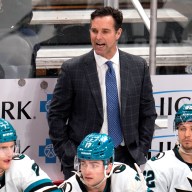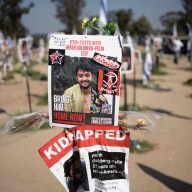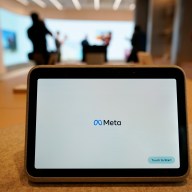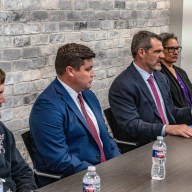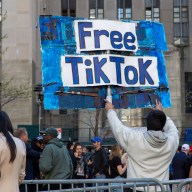“Peter and the Starcatcher,” a new play about magic and adventure on the high seas, had its own long and exciting journey on its way to the Brooks Atkinson Theatre:
• Authors Ridley Pearson and Dave Barry first published the children’s novel about the Peter Pan origin story in 2006.
• It was adapted for the stage in California before it became an off-Broadway workshop in 2011.
• Finally, the current version hit the Great White Way this April.
Intrigued? So were we! That’s why we met up with playwright Rick Elice to learn all about the process of taking “Peter and the Starcatcher” from bookshelves to Broadway.
So what are the origins of the origin story – how did the idea to do a staged “Peter and the Starcatcher” come about? And how did you get involved?
Ridley Pearson had a daughter who was 7 or 8 years old and they went to Disney World, I think, and she said, “How did Peter Pan learn to fly?” He and Dave Barry are in a rock band together [The Rock Bottom Remainders]. They met shortly thereafter and he said, “Suddenly it occurred to me in this new era of origin stories [that] nobody’s done Peter Pan. And maybe we should.” They began to exchange this chapter by chapter via the Internet, until they had a 500-page novel. They took it to Hyperion, and they published it. It was in galley form when it first came to Tom Schumacher, who runs Disney Theatrical Productions.
There was no budget, Tom just said, “See what you think.” So, with a handful of non-equity interns, they worked up a section of the novel to present to Tom. He said he’d give them like $500 to do another workshop here in New York that fall. The $500 went toward renting out a room in a church on the Upper West Side. The same non-equity interns showed up. Now they wanted to do a big stretch of the play they hadn’t done before; for that, they needed some text. So [directors Roger Rees and Alex Timber] just called a writer they both knew, which was me, and said, “Can you write some scenes?” And that workshop was attended by Dave Berry and Ridley Pearson. … They asked who wrote the stuff that they’d heard the actors saying, I guess because they liked it. Tom said, “It’s that guy sitting over there.” And they just asked if I was going to write the rest of the play. And Tom Schumacher said, “Yes.” That’s how it was decided that I was going to write the play. So I really sort of backed into it.
It was a children’s book, but your play is targeted toward those 10 and up – is that because it has more adult content?
[At La Jolla, three years ago] young mothers were coming with 2- and 3-year-olds in tow, thinking they were going to see “Peter Pan” or a children’s novel adapted by Disney to be a children’s theater piece, which is exactly what I didn’t want to do. We suggest [audiences] of 10 and up, because we figure that, New Yorkers being New Yorkers, you know they’ll say their 8-year-old is just so special. And, you know, they’re right. But if you say it’s appropriate for 8, they’ll start bringing 6-year-olds. And then it starts getting a little dodgy. And I don’t want people like me not to go because they’ll think it’s like sitting on the airplane next to the screaming kid.
So what was your way into it?
I wanted to write the play from the perspective of this empowered girl – self-assured, super smart, super curious, not a spectator in her own life, active in her own life story – who teaches this boy how to be a man, really. … I love the idea that this is a girl-power story, really, because the hero of this story is a girl.
I was almost thinking it should be called “Molly and the Boy,” not “Peter in the Starcatcher” – since it’s mostly about her, and he doesn’t even have a name at first.
I would have! … I went to Disney and said, “I’d like to change the title.” And they said to me, very quickly, “No, because ‘Peter and the Starcatchers’ is our book, and the only reason we’re interested in doing this at all is because it’s going to help us sell our book. It would be foolish of us to let you change the title.”
How closely does the play follow the novel, and how much liberty did you have?
[After La Jolla], I had this thought that I would kill off one of the boys, this little boy, the littlest boy – Jim was his name, Little Jim, the kid who got beaten up. I thought if I got rid of Jim, [then I could] give all those qualities to Peter, and stop calling him Peter, and stop thinking of him as the leader. He’s this little boy in the corner, the one who nobody almost sees in the beginning because the other two are talking. Suddenly the girl notices him – the way you would notice someone more interesting, even if they weren’t speaking. And he doesn’t want any part of it. And because he doesn’t want any part of it, she’s all the more intrigued. [I thought I’d] make him the kid who gets beaten, make him the kid who doesn’t talk. So by the end of the play, he’s really traveled a great distance, emotionally and psychologically, in terms of his maturity.
And [I wanted to] get rid of the idea that the world is full of these people called Starcatchers who find this starstuff … eliminate all the other Starcatchers in the story, except the father, and make the girl an apprentice. So at the end of this story, this boy can become Peter and this girl can become the Starcatcher. So I asked Disney, “Can I just drop the “S” [from ‘Peter and the Starcatchers’]?” And they’re like, “Why?” And I said, “Now it’s the title of the play we’re going to do, and not just the title of the novel. So ‘Peter and the Starcatcher’ means him and her specifically. The book isn’t about that, but the play is.” And they said, “Okay.” So it’s interesting you said a more perfect title of the play would be “Molly and the Boy” – because in a way, it’s exactly the title of the play.
How did it change since the workshop last year?
The play’s about 10 minutes shorter, the scenes are in a different order because some people found it confusing. … We only go back and forth half as much as we used to last year, so people could settle in. I delayed the appearance of the villain later until the boy and the girl were very clearly introduced. You used to meet the Hook character right away. It occurred to me that you needed to meet the title characters and establish them, and the third character in the triangle would be the villain. And I think that helps the whole play overall. And it also helps the impact of Christian Borle [“Smash”] – this wonderful actor who plays this character in the play – because just at the point when you’re ready for the next thing, there he is. And he absolutely kicks it back up to another level.
And then the stuff that’s a big difference, for me, is the big stuff you never could have anticipated. Everything’s theoretical, of course, until you’re actually doing it. Last year, Disney decided that they weren’t going to produce the play for a variety of reasons that had very little to do with the play. So we had to find someone else to produce it, if possible. We brought a lot of people down. People tended to like the play a lot, but no one was really interested in producing it. They thought, “It’s lovely right down here in this 175-seat theater, it should just be here, it’s perfect for here. Don’t move it to Broadway, it’ll never play in a bigger house.” You don’t want to believe that if you don’t think it’s true. If enough people say the same thing, the whole world can’t be crazy. I said to myself, “Maybe you’re crazy.” Then out of the blue came a guy who said he was going to produce it, and he brought down a partner. And they went out to raise money, and they did. And they said they were going to get a theater, and they did. It all seemed so improbable, really, until the end of January.
But you always felt pretty sure you wanted it to go to Broadway?
Well I always imagined it. I don’t know how to write for off-Broadway! I’m a Broadway guy; it never occurred to me that it wasn’t for Broadway. So I didn’t think that it was going to be that big of a deal to transfer it, especially if the response downtown was strongly positive – which it was. I thought this is supposed to be what happens – it’s a modest enterprise. You don’t open it in a grandiose way, you open it in a modest way, see if it catches on, and you move it. And then you get on with your life.
And we have to ask, because of your writing history [“Jersey Boys,” “The Addams Family”] – did you ever think about making this a musical?
Only after the fact. It was suggested as a play to the directors. The directors conceived it as a play; they asked me to write a play. When I said yes, they said, “Here’s the challenge: We’re not going to have a lot of budget. … The only thing we have an unlimited amount of is imagination and words – words are free. So use words to your heart’s content. We want it to be low comedy, we want it to be high comedy. We want it to be very, very silly – and we want it to be sentimental. We want it to be smart, we want it to be accessible. So do all of that.” And I said, “Okay. But one of the things you can do with words is set them to music. Can I have a couple of songs?”
Might it have been easier to get the play to Broadway [as a musical]? It’s likely. But that’s not what we were doing, and what we were doing kept seeming to assert itself. After awhile, a play becomes a thing and it has its own ego and its own demands and its own personality. … No one thought about making this a musical, so that’s why it’s a play.
For more, “catch” our review of “Peter and the Starcatcher.“





